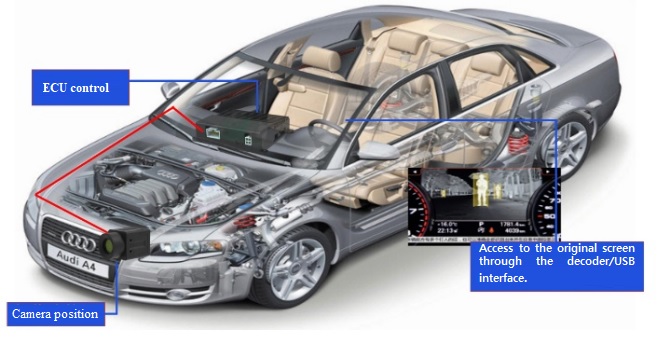2024 B2B Market Trends in Car Thermal Cameras: A Comprehensive Analysis

Car Thermal Cameras Overview
The upcoming "2024 B2B Market Trends in Car Thermal Cameras" blog will explore the current landscape of vehicle infrared thermal cameras. This comprehensive analysis will delve into the market size and growth trends of these innovative technologies, shedding light on their increasing significance in the automotive industry.
Throughout the blog, we will provide insights into the evolving market dynamics and technological advancements shaping the vehicle thermal imaging sector. Stay tuned for a detailed exploration of how these trends are influencing fleet monitoring, automotive safety integration, and overall market growth.
Stay tuned for a comprehensive understanding of the latest developments in vehicle thermal imaging technology!
Fleet Monitoring Advantages
Fleet monitoring with thermal cameras offers numerous advantages for businesses and their vehicle fleets. Let's explore the key benefits:
Enhanced Vehicle Monitoring
Real-time monitoring of vehicle fleets becomes significantly more efficient with the integration of thermal cameras. These advanced systems provide a comprehensive view of the vehicles, allowing for better tracking and management.
Improved Safety Measures
The incorporation of thermal cameras in fleet monitoring plays a pivotal role in enhancing safety measures. By providing enhanced visibility, these systems reduce the risk of accidents and contribute to overall road safety.
In the words of industry experts, "The integration of thermal cameras has revolutionized fleet monitoring, offering unparalleled visibility and safety features."
Automotive Safety Integration
In the realm of automotive safety integration, the incorporation of thermal cameras has redefined vehicle safety technology. These advanced systems are seamlessly integrated into automotive safety systems to provide enhanced visibility in various driving conditions. By leveraging thermal imaging technology, these cameras offer improved vision in challenging environments, such as low light or adverse weather conditions.
Industry Expert: "The integration of thermal cameras has significantly enhanced the safety features of modern vehicles, providing drivers with a clearer and more comprehensive view of their surroundings."
The impact of thermal camera integration extends to accident prevention as well. These innovative systems contribute to accident prevention by providing advanced warning of potential hazards on the road. With real-time detection capabilities, thermal cameras enable drivers to anticipate and react to obstacles or dangers in their path, thereby reducing the likelihood of accidents.
Incorporation of Thermal Cameras
Thermal cameras seamlessly integrate into automotive safety systems, enhancing visibility and providing drivers with a clearer view in challenging driving conditions.
These advanced systems offer improved vision in low light and adverse weather conditions, contributing to overall road safety.
Impact on Accident Prevention
Thermal cameras play a crucial role in accident prevention by providing advanced warning of potential hazards on the road.
Real-time detection capabilities enable drivers to anticipate and react to obstacles or dangers, ultimately reducing the risk of accidents.
Vehicle Thermal Imaging Technology
Technological Advancements
In the realm of vehicle thermal imaging technology, significant advancements have reshaped the automotive industry. These innovations have revolutionized the way vehicles utilize thermal imaging for enhanced safety and operational efficiency.
One notable advancement is the integration of artificial intelligence (AI) algorithms with thermal imaging systems. This integration enables vehicles to interpret thermal data more effectively, leading to improved hazard detection and driver assistance. Additionally, the development of high-definition thermal sensors has elevated image quality, providing clearer visibility in various driving conditions.
Furthermore, automotive thermal imaging advancements have seen the emergence of multi-sensor fusion technology. By combining thermal cameras with other sensor technologies such as LiDAR and radar, vehicles can achieve a comprehensive perception of their surroundings, enhancing overall safety and autonomy.
Market Growth and Size
The market for vehicle thermal imaging technology is experiencing robust growth, underscoring its increasing significance in the automotive sector. With a surge in demand for advanced safety features and autonomous driving capabilities, the adoption of thermal imaging technology is on an upward trajectory.
This growth is further fueled by technological innovations that have made thermal imaging systems more cost-effective and accessible for vehicle manufacturers. As a result, the market size for vehicle thermal imaging technology is expanding rapidly, reflecting its pivotal role in shaping the future of automotive safety and driving experiences.
Car Thermal Cameras Market Analysis
As we conclude our analysis of the 2024 B2B Market Trends in Car Thermal Cameras, it's evident that the vehicle thermal imaging market is undergoing significant growth and technological advancements. The integration of thermal cameras in fleet monitoring and automotive safety systems has redefined operational efficiency and road safety measures. Moreover, the market for vehicle thermal imaging technology is expanding rapidly, reflecting its pivotal role in shaping the future of automotive safety and driving experiences.
The blog aims to provide an informative and educational analysis, catering to a wide audience while maintaining a readability level suitable for 8th-9th graders.
See Also
2024: Exploring State-of-the-Art Thermal Cameras for Fleet Safety with Plus and Teledyne FLIR
2024 Drone Thermal Camera Guide: Exploring Varieties & Technologies
2024 Enterprise Car Thermal Cameras Compared
Discovering Uses of Thermal Imaging Cameras in Drone Field Equipment
Complete Manual for Purchasing the Most Inexpensive Drone with Thermal Camera
Contact Us: Ms. Coco Huang
E-mail: sales@iasun.cn
WhatsApp/Wechat: +86 13510421923

